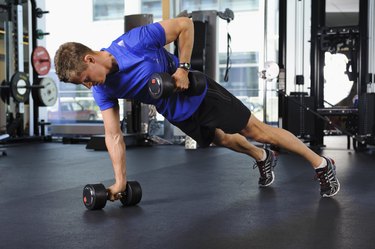
Different workouts help you achieve different fitness goals, like running to gain endurance or lifting weights to build muscle. But whether you want to get stronger, faster or fitter, you would be smart to tap into the power of interval training.
If fitness were a continuum, you would have endurance, or your body's ability to perform an action for an extended amount of time, on one end. On the other, you have strength, or your body's ability to produce force. Interval training can help you improve both.
Video of the Day
Video of the Day
What Is Interval Training?
"Interval training is an umbrella term for exercise protocols that involve alternating between periods of relatively high-intensity exercise with periods of recovery," Jenna Gillen, PhD, assistant professor of exercise physiology at University of Toronto, says.
A sort of middle ground of exercise methods, interval training can be used to develop your endurance, your strength or a combination of both. Interval training workouts can be designed in countless ways based on a person's activity, goals and current fitness level.
During each period of work, you perform an exercise at a specific level of intensity for a set length of time or distance. That is followed by a period of lower-intensity effort or rest. The up-and-down effort levels are what makes it different from steady state, or continuous exercise training.
Interval training is often used with various forms of cardio (running, cycling, rowing, swimming, jump rope) as a way to work harder than you could at a continuous effort; it can also be implemented within strength workouts as well as a way to boost speed, power and overall fitness.
"The purpose of interval training is based on whatever the person performing it wishes to improve," exercise physiologist Jim White, CPT, says. "Generally, I think interval training is great for improving cardiovascular fitness and athletic performance."
White also touts interval training's benefits for weight loss. "It is an exceptional method for burning calories and decreasing body fat percentage," he says, "while still providing a significant increase in muscle strength, depending on exercises performed and the focus of the training."
The Main Types of Interval Training
Interval training is a very broad term. Any kind of exercise that alternates between periods of effort and periods of recovery is technically a form of interval training.
"Some people have this notion that interval exercise is only this all-out, as-hard-as-you-can-go effort — but that's not the case," Martin Gibala, PhD, professor of kinesiology at McMaster University in Hamilton, Canada, says. That's likely because of the enduring popularity of HIIT, even though that's just one form of interval training.
According to Gibala, you can even benefit from interval training if your typical exercise is just walking around the block. "Researchers in Denmark studied people with type 2 diabetes who were put on a walking program," he explains, referencing a February 2013 study in Diabetes Care. "One group performed continuous, steady-state walking and the other group performed gentle interval walking — picking up the pace for a few minutes, and then backing off."
"After several months, the interval walkers were more fit, had dropped more body fat and had improved their blood sugar control to a greater extent than the continuous walkers," he says.
These are a few of the main forms of interval training. "There's a style of interval training that is suitable for just about anyone," Gibala says.
1. High-Intensity Interval Training
Also known as HIIT, this style of interval training focuses on "near maximal" efforts with target heart rates around 80 percent (but often 85 to 95 percent) of your max heart rate. The period of "work" can last anywhere from a few seconds (for lesser-trained individuals) to a few minutes. The length of the interval is less important than the effort. For it to be HIIT, you need to be reaching that almost all-out effort.
2. Sprint Training
Sprint interval training (also referred to as SIT) is characterized by efforts performed at intensities equal to or greater than your all-out max. For example, a sprint interval training workout might be cycling or running at 100 or even 150 percent of your maximum heart rate. These types of workouts are typically reserved for athletes who are more experienced or have higher levels of fitness.
3. Tabata
Commonly grouped in with HIIT exercise, the Tabata method is a specific work-to-rest ratio protocol consisting of 20 seconds of super-intense effort, followed by 10 seconds of rest. This pattern is repeated continuously for four minutes, or eight total sets. It is based on a landmark October 1996 study in Medicine & Science in Sports & Exercise of Olympic speedskaters who, performing this workout on stationary bikes, reached an intensity of 170 percent of their VO2 max during the 20-second efforts. Technically, this style of interval training qualifies it as sprint training as opposed to HIIT.
4. Fartleks
A Swedish term meaning "speed play," this is a more unstructured and casual form of interval training predominantly used by distance runners. Rather than the rigid time periods of most interval training workouts, fartleks are often performed by mixing in periodic bursts of higher-intensity effort in the middle of a steady-state run at more random intervals (for example, selecting a lamp pole or mailbox up ahead of you and picking up the pace until you reach that landmark). It's a great way to vary your workout mid-session, as well as fight off mental boredom or fatigue.
5. EMOM
Every Minute on the Minute (or EMOM) has become a popular style of interval training in the strength training world. For this style of workout, you perform a predetermined number of reps of a particular exercise within 60 seconds. You then use whatever time is left in the minute to rest, before moving onto the next set. The slower you complete the exercises, the less time you have to rest, incentivizing you to work at a higher effort in a shorter amount of time.
6. Low-Intensity Interval Training
Also known as LIIT, this style of training has become more popular over the last decade as a way to reap the known benefits of interval training without the intensity of HIIT or sprint training. While those styles of interval training might push you to 95 percent or greater of your maximum heart rate, LIIT tends to have work intervals around 70 to 80 percent of your max. It can be the same exercises you would do in HIIT training — running, rowing, even weight-lifting — but the intensity is lower, according to the Cleveland Clinic. This is a great option for older adults, as well as people who are just starting an exercise routine or coming back from an injury.
Related Reading
Benefits of Interval Training
Interval training is a well-loved workout approach because it leads to a significant range of fitness and health benefits.
Interval training, like all workouts, can help to decrease body fat, increase strength and endurance and improve health outcomes. Unlike steady-state workouts, its time efficiency is a huge advantage (and a big reason for its popularity).
In a March 2014 study in Applied Physiology, Nutrition, and Metabolism, Gillen and her team found that as few as three HIIT sessions per week, involving less than 10 minutes of intense exercise and less than 30 minutes total per session, improved aerobic capacity, skeletal muscle oxidative capacity, exercise tolerance and markers of disease risk after only a few weeks in a wide range of adults.
And it might not even take three times a week to get some of the benefits, says Gibala, citing a large 2006 study in the European Journal of Cardiovascular Prevention and Rehabilitation, part of the HUNT Study, that followed more than 55,000 people for 16 years. "Even one weekly bout may be beneficial, per the HUNT study, which suggested a single weekly bout of exercise of high intensity reduced the risk of cardiovascular death in men and women," he says.
What's more, a December 2022 study in Nature Medicine revealed that non-exercisers who did at least three short bouts of vigorous intermittent lifestyle physical activity (meaning it was mixed into their everyday life rather than a formal workout) showed a 40 percent reduction in all-cause and cancer mortality risk and a 49 percent reduction in risk of cardiovascular death.
Is Interval Training Good for Losing Weight?
A common benefit gym goers are looking for is whether or not their hard work will translate to a smaller waistline or lower number on the scale. When it comes to interval training, it's definitely an added benefit.
"Interval training is a great method for weight loss," says White. "You're burning a high amount of calories and, over time, improving your body's cardiovascular system, which can lead to further metabolic improvements."
Those improvements can enhance the efficiency within your cardiovascular system and make it easier for your body to become fitter, he says. The fitter you are, the easier it becomes to burn body fat.
Are There Risks of Interval Training?
It can be easy to jump into a new workout routine with an overly ambitious plan. It's not uncommon for people who are new to interval training to feel an increase in fatigue during and after their first few weeks of training. Particularly with high-intensity interval training and sprint training, you run the risk of pushing your body too hard too soon, which can lead to injury.
The best way to mitigate your risk of injury or burnout is by starting off slowly, especially if you're just starting an exercise routine or coming back after a long time off. According to updated recommendations from the American College of Sports Medicine (ACSM), physically inactive but otherwise healthy people may start light to moderate-intensity exercise without medical clearance; in the absence of symptoms, they can then progress gradually in intensity.
So you can start with LIIT for a few weeks, and if everything feels good, begin to raise your effort level during your intervals.
However, ACSM still recommends that physically inactive individuals with known cardiovascular, metabolic or renal disease — or those with symptoms of these diseases — see their doctor for medical clearance before starting an exercise program of any intensity.
The Best Interval Training Workouts
When it comes to finding the best HIIT exercises or interval workouts to follow, there are a ton to choose from, including HIIT exercises at home. But Gillen stresses that the most important thing is to not overthink it.
"If you are alternating between relatively intense periods of exercise and periods of rest, you are doing interval training!" she says. "Protocol options are infinitely variable, and many exercise modes and interval durations are effective. Pick something you enjoy and try to incorporate it regularly into your fitness routine."





